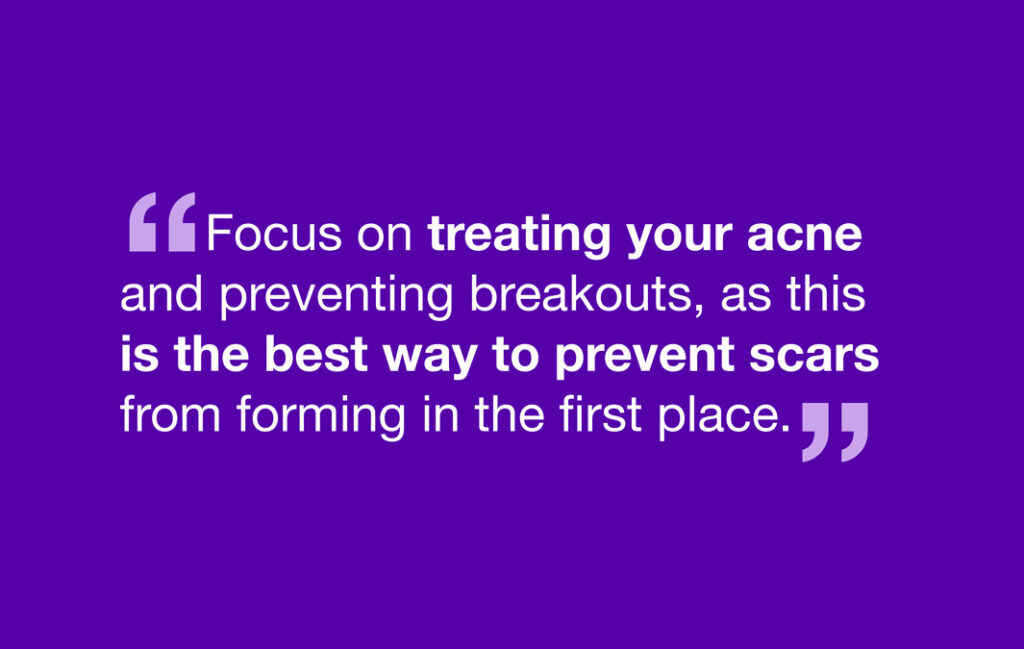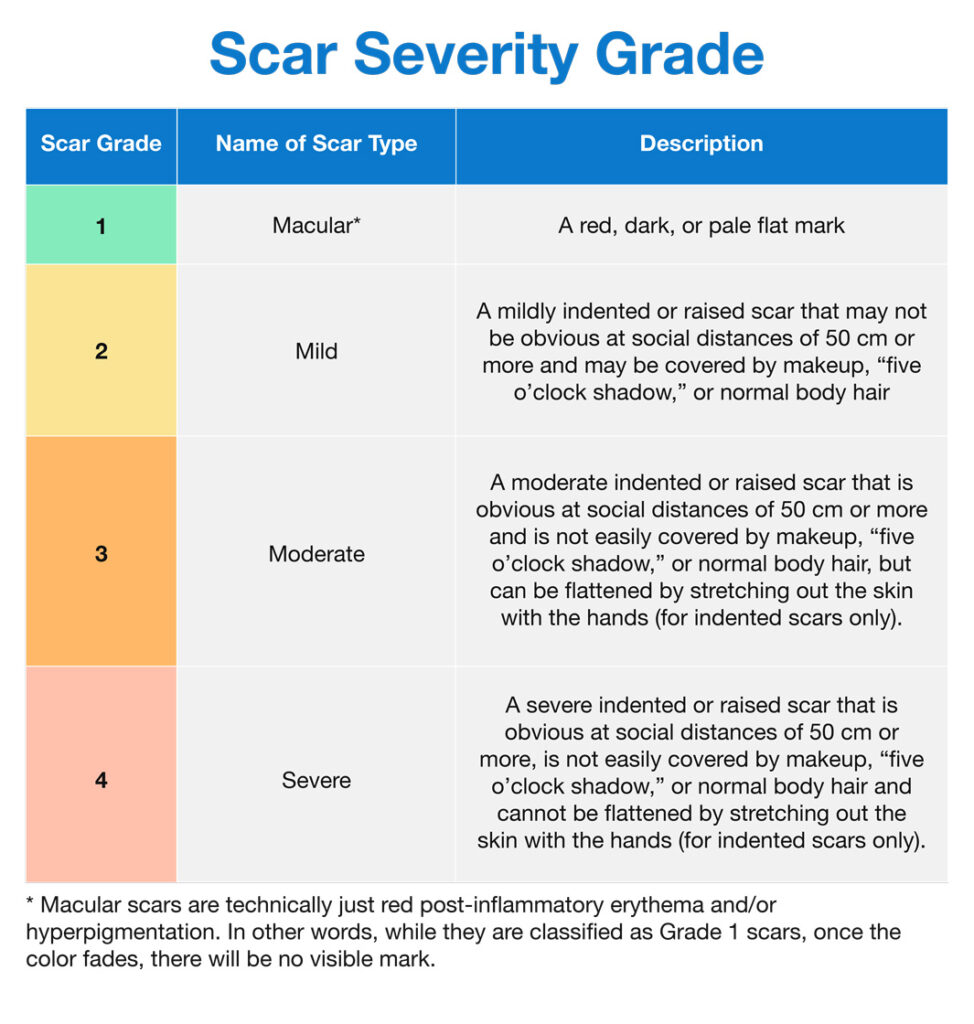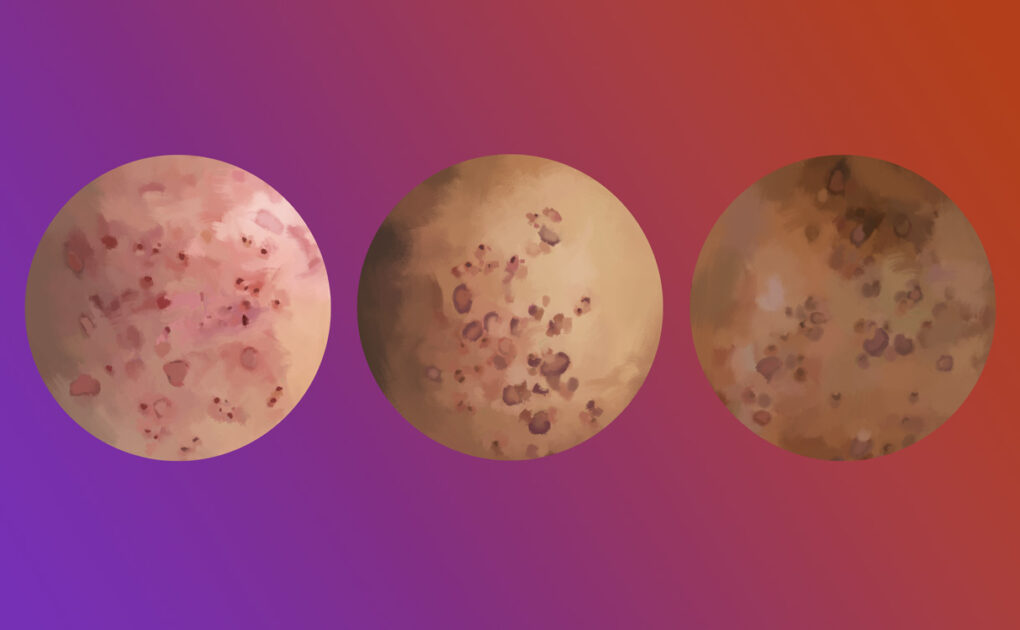Skin That Is Healing from Acne Lesions Is More Transparent and Contains More Tiny Blood Vessels, Which Show Through as Red

The Essential Info
Acne scars can appear as a variety of different colors: red, purple, or brown. The color of a scar is due to one of two processes:
- Post-inflammatory erythema (redness): This process brings more blood to the damaged skin to help with the healing process. The result is a temporary red or purple color, depending on the skin tone. The redness typically fades within three months, although it can sometimes take longer.
- Post-inflammatory hyperpigmentation (darkening): This process occurs when prolonged inflammation, such as often happens in acne lesions, causes the skin to produce too much of the dark pigment melanin. The result is a brown color that can take a year or more to fully fade.
A red or purple color indicates a newer scar that is still in the early stages of the healing process. The redness should pale over the course of a few months.
Not All Red/Purple Marks Are Scars: Keep in mind that a red/purple mark left over after an acne lesion isn’t necessarily a scar. When an acne lesion is healing, you may see skin redness or skin darkening without scarring, and when the skin returns to its natural color over time, there may be no scar remaining.

The Science
- What Determines the Color of a Scar?
- What You Can Do to Prevent or Reduce Scar Redness
- Treating Red/Purple or Dark Scars
- Scar Redness Is an Important Stage of Healing
It’s common for new acne scars to have a red or purple tint. In fact, 83% of scars start out red/purple.1 Broadly speaking, the redness of a scar tells you two things:
- It’s recent: A red/purple scar is usually very recent, formed in the past 3 months or less.
- It’s inflamed: Redness is a sign of inflammation, the same process that causes acne lesions themselves to be red. The redder the scar, the more inflammation there is under the skin surface.2,3
As the skin heals, the redness will naturally fade.
Sometimes, the scar can also look darker than the surrounding skin. Let’s explore why acne scars can have different colors and how soon you can expect those colors to disappear.
Note: Not all red, purple, or dark marks left behind after acne lesions will end up leaving scars. In many cases, once the color fades, there may be no noticeable scar remaining.
What Determines the Color of a Scar?

Two separate processes can give a scar a different color than the surrounding skin, and both of them have complicated names:
- Redness or Post-inflammatory Erythema (PIE): This process makes a scar look red, pink, or purple, depending on the person’s skin tone. PIE is more common in people with fair skin. PIE fades on its own over the course of about three months.
- Darkening or Post-inflammatory Hyperpigmentation (PIH): This process makes a scar look dark, such as tan, brown, or dark brown, depending on the person’s skin tone. PIH occurs more often in people with darker skin. Without treatment, PIH gradually fades over the course of a year or more.4
As a rule of thumb, the color of your scars will depend on your natural skin tone:
- If you have lighter skin: If you have lighter skin, you are more likely to see red/purple scarring than dark scarring as your acne lesions heal. This redness doesn’t require treatment and will fade on its own over a few months. Occasionally, a light pink color may remain for a year or more.4,5
- If you have darker skin: If you have darker skin, you are more likely to see dark scarring than red/purple scarring as your acne lesions heal. This darkening can take a year or more to fully fade. The authors of a 2018 article in the Journal of Drugs in Dermatology wrote, “[Post-inflammatory hyperpigmentation] will fade away over time, even without treatment. It can take three to 24 months for PIH to fully fade, although in some cases it may take longer.”4
Let’s take a closer look at each of these two possibilities and why they can occur.
Why redness or post-inflammatory erythema (PIE) occurs
PIE, or scar redness, is caused by three interconnected events that are occurring in the skin as it heals from acne lesions:
- Increased blood flow due to inflammation: Acne is an inflammatory disease, and inflammation is still there when an acne lesion begins to heal. Inflammation causes tiny blood vessels around the acne lesion to widen (dilate), increasing blood flow to the area to help with healing. In addition, inflammation makes the tiny blood vessels leakier (more permeable), so that more blood enters the damaged skin. The increased amount of blood under the skin surface causes redness.
- Formation of new blood vessels (vascularization): Long-standing inflammation also triggers the second process, the formation of new blood vessels in the skin. The increased number of blood vessels further contributes to the red appearance of the scar.
- Skin thinning: When the skin is healing from an acne lesion, it is temporarily thinner and more transparent. This may be due to thinning of the so-called “skin barrier” (scientifically known as the stratum corneum), which is the topmost layer of the skin. Because thinner skin is more transparent, the blood vessels underneath show through more clearly, making the skin look redder.3-5
Why darkening or post-inflammatory hyperpigmentation (PIH) occurs
PIH, or scar darkening, also results from inflammation in the early stages of lesion healing. Depending on which layers of the skin the dark color is coming from, it may have more of a dark brown or more of a blue tinge:
- Darkening in the outer layer of the skin (the epidermis): The outer layer of the skin darkens when inflammation stimulates the skin to produce the pigment melanin. This is the same pigment that the skin produces after we have been out in the sun, making us look tan. When an acne lesion heals, inflammation can trigger excess melanin production in the spot where the lesion used to be, making that spot temporarily darker than the surrounding skin.
- Darkening in the deeper layer of the skin (the dermis): The deeper or inner layer of the skin darkens when inflammation damages cells deep in the skin, making them release large amounts of melanin. The excess melanin so deep in the skin can give the skin a bluish tinge.5
What You Can Do to Prevent or Reduce Scar Redness

To help prevent red or dark acne scars, keep these tips in mind:
- Never pick at pimples, as this can increase the chances of both scarring and skin darkening (hyperpigmentation). However, it’s okay to pop pimples, as long as you do it properly.
- Protect your skin from the sun, as the sun’s rays can darken scars. Use a broad-spectrum sunscreen or a facial moisturizer containing sunscreen with an SPF (sun protection factor) of at least 15. Look for products that are non-comedogenic (won’t clog pores) or are labeled “for acne-prone skin.”
- Focus on treating your acne and preventing breakouts, as this is the best way to prevent scars from forming in the first place.6
Treating Red/Purple or Dark Scars
Treating red/purple scars: If you already have scars that are red or purple, be patient, as the scar color will fade on its own in a few months. No treatment is necessary.
Treating dark scars: As we have seen, skin darkening can take a year or more to fully fade. However, various treatments can help reduce the dark spots. Some options include topical retinoids, superficial skin peels, over-the-counter glycolic acid, hydroquinone, and topical steroid creams.4
When it comes to red/purple scars, it may make you feel better to know that the redness actually serves a purpose. Read on if you’re curious to find out more.
Scar Redness Is an Important Stage of Healing
As we have seen, “young” scars tend to be red because of increased blood flow to that area of skin. This extra blood flow brings many important substances to the skin as it heals, including:
- Nutrients
- Oxygen
- Growth factors to stimulate growth of new skin cells and skin proteins
As the skin heals from an acne lesion, new collagen forms to fill in the “gap” left by the lesion. Collagen is the protein that makes the skin firm but stretchy. The more collagen that fills in the area, the more the scar fades from red to a paler color. As the scar progresses into later stages of healing, increased blood flow to the area is no longer necessary, and the skin gradually returns to its normal shade.
To learn more about the stages of lesion healing and how scar color changes in each stage, expand the section below.
The Stages of Acne Lesion Healing
In a medical sense, an acne lesion is a small wound. When an acne lesion heals, it passes through the three stages of wound healing, which can overlap:
- Inflammation: As we have seen, inflammation occurs during acne itself as well as in the first stage of acne lesion repair. Inflammation is visible as a red or purple color, swelling, and pain at the lesion site. When the skin is healing from an injury, inflammation typically lasts around 6 days, but in the case of acne lesions, it can stick around much longer.
- Cell proliferation: During this stage, new skin cells grow (“proliferate”) quickly to replace skin cells damaged in the acne lesion. At the same time, new blood vessels form to supply blood to the newly growing skin. Also, an immature form of collagen starts to fill in the wound. This stage can last up to 4 weeks, during which time the scar continues to look red.
- Remodeling or maturation: During this stage, the skin “remodels” or reshapes the immature collagen formed in Stage 2, replacing it with a mature form. This stage begins around the fourth week of wound healing and can last for years, depending on the depth of the skin damage. During this stage, the red color of the scar gradually pales.5,7
Not All Acne Lesions Become Scars
Not all acne lesions are destined to leave a scar once they heal. A study published in the Journal of Drugs and Dermatology in 2017 found that only 5.7% of acne lesions (including whiteheads, blackheads, papules, and pustules) left a scar. In most cases, before the scar formed, the lesion location looked red or dark, and the scar developed later.1
The same researchers also found that when a scar did form, in 82% of cases, it was still there two years later.1
Even when scars form, they can differ widely in severity. Dermatologists use the following grading system to indicate how severe a scar is:2,8

*Macular scars are technically just red post-inflammatory erythema and/or hyperpigmentation. In other words, while they are classified as Grade 1 scars, once the color fades, there will be no visible mark.
Acne scars can be treated with a variety of options, including laser therapy, fillers, and others.6
References
- Tan, J. et al. Prospective study of pathogenesis of atrophic acne scars and role of macular erythema. Journal of Drugs in Dermatology 16, 566–572 (2017). https://pubmed.ncbi.nlm.nih.gov/28686774/
- Bae-Harboe, Y.-S. C. & Graber, E. M. Easy as PIE (Postinflammatory Erythema). The Journal of Clinical and Aesthetic Dermatology 6, 46–7 (2013). https://www.ncbi.nlm.nih.gov/pmc/articles/PMC3780804/
- Yang, Y., Wu, X. & Liu, W. Scar symptom: Erythema and thickness. in Textbook on Scar Management 103–108 (Springer International Publishing, 2020). doi:10.1007/978-3-030-44766-3_11.
- Fabbrocini, G. & Cacciapuoti, S. Evaluation, prevention, and management of acne scars: Issues, strategies, and enhanced outcomes. Journal of Drugs in Dermatology 17, S44-48 (2018). https://pubmed.ncbi.nlm.nih.gov/30586481/
- Wound Healing and Repair: Overview, Types of Wound Healing, Categories of Wound Healing. https://emedicine.medscape.com/article/1298129-overview#a4
- McGoldrick, R. B., Theodorakopoulou, E., Azzopardi, E. A. & Murison, M. Lasers and ancillary treatments for scar management Part 2: Keloid, hypertrophic, pigmented and acne scars. Scars, Burns & Healing 3, 205951311668980 (2017). https://www.ncbi.nlm.nih.gov/pmc/articles/PMC5965340/
- Baron, J. M., Glatz, M. & Proksch, E. Optimal support of wound healing: New insights. Dermatology 236, 593–600 (2020). https://www.karger.com/Article/FullText/505291
- Moawad, O. Acne scars: A new approach. 1–5 (2015). https://www.researchgate.net/publication/283194598_ACNE_SCARS_A_NEW_APPROACH
